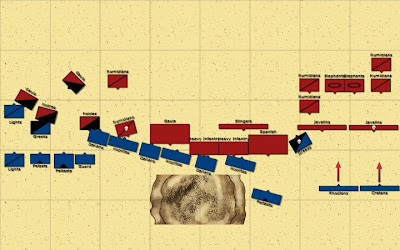
This is the first of a pair of posts describing the Carthaginian invasion of Sicily. Simon constructed and deployed the Carthaginian army (in red above). Their right wing was composed of:
- Two units of 12 Elite Noble Heavy Cavalry
- Two units of 12 Veteran Gallic Cavalry
- Two units of 8 Veteran Numidian Light Cavalry
In the centre was massed their heavy infantry:
- 48 Gauls deployed in four ranks
- Two units of 48 Heavy Infantry deployed in four ranks
- 48 Spanish deployed in four ranks
- 10 skirmish slingers
Their left was composed of:
- Two units of 8 Veteran Numidian Light Cavalry
- Two units of 2 African Elephants
- Two units of 8 Veteran Numidian Light Cavalry
- Two units of 10 skirmish javelins
Simon played their right wing and Mark the left; they shared command of the centre. I constructed and set up the Syracusan army. Our left (me in charge):
- Two units of 8 Veteran Light Cavalry
- 12 Veteran Greek Medium Cavalry
- 12 Veteran Peltasts
- A large unit of 18 Veteran Peltasts in three ranks
- The Tyrant's Guard: 24 Elite Hoplites in three ranks. These set up behind the first of the centre command's units, intending to move wide against the expected heavy Carthaginian cavalry presence.
Our centre (Billy in command):
- Three units of 36 Veteran Hoplites in three ranks, interspersed with:
- Three units of 32 Veteran Italian medium foot in four ranks
- and 14 skirmish javelinmen out front
Our right (John):
- 18 Veteran Peltasts deployed wide in two ranks
- 12 Veteran Greek Medium Cavalry
- 8 Veteran Rhodian Slingers
- 8 Veteran Cretan Archers
The battle began as follows:

This was John's first visit to the club, and his first taste of the rules. Rather than mess him around with too much information, we thought it would be a good idea if he were to take the Sicilian skirmishing right wing. This would give him a good view of the whole battle as well as introducing him to the game. He immediately started to use his skirmishers to devastating effect, keeping them out of range of the enemy javelinmen and shooting them up quite happily. In our centre, we wheeled our infantry and started to advance them; on the left, we began to push forward with our mixed bag of light troops and medium cavalry. The Carthaginians advanced their infantry centre as well.

The third image, above, shows the advance of the entire Carthaginian army, with some of their heavy cavalry peeling off to face our potential flanking movement.

The fourth map shows the initial contacts. The Carthaginians were planning to use their large central infantry units to win through, while masking them with a large number of small cavalry units and elephants. On our left, the performance of the Carthaginian heavy cavalry was miserable, much to our relief. Unfortunately, however, one of our Italian columns was caught by a ferocious Gallic warband charge, rendering our centre immediately vulnerable. To our right, John sent in the medium horse at an angle to inflict as much damage as possible on the Spanish Infantry before being crushed themselves. His skirmishers were meanwhile continuing to enjoy themselves immensely.

The final image shows stalemate across the entire front as most of the Carthaginian army ground to a halt, inflicting very little damage at all. Our left and centre continued to hold firm as a result. The only real movement was the large mass of Carthaginian troops on their left, although half of their skirmishers were by now defunct.












.jpg)

































.jpg)













.jpg)




.jpg)


































































 On our left, we destroy both Gallic cavalry units, while losing our second unit of light cavalry. The Italians just don't quite reach the flank of the Carthaginian heavy infantry, and the rest of our centre collapses. John's heroic Rhodians and Cretans destroy more Numidians and a unit of elephants but it's game over, as Carthage wins by four figures.
On our left, we destroy both Gallic cavalry units, while losing our second unit of light cavalry. The Italians just don't quite reach the flank of the Carthaginian heavy infantry, and the rest of our centre collapses. John's heroic Rhodians and Cretans destroy more Numidians and a unit of elephants but it's game over, as Carthage wins by four figures.



